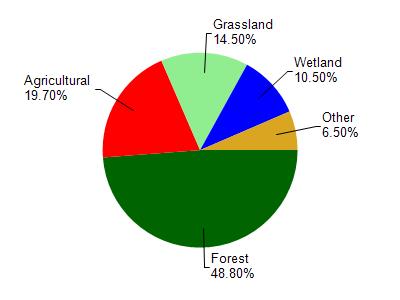Chippewa
No
No
No
Fish and Aquatic Life
Overview
Dark Lake, in the Lake Chetek Watershed, is a 16.26 acre lake that falls in Chippewa County. This lake is managed for fishing and swimming and is currently not considered impaired.
Date 2011
Author Aquatic Biologist
Historical Description
Source: 1963, Surface Water Resources of Chippewa County Dark Lake - Town of Sampson West T32N, R9W, Section 10
A soft water, seepage lake with an intermittent outlet to Axhandle Lake. A water control dike structure of three feet is located on the outlet. It is a rehabilitated trout lake having brook and rainbow trout present. Puddle ducks use the lake area for nesting. Public frontage on the lake amounts to 250 feet of lake shore on the town road access. It has no privatedevelopment.
Surface Acres = 13.0, S.D.F. 1.39, Maximum Depth = 60 feet
Date 1963
Author Surface Water Inventory Of Wisconsin
Condition
Wisconsin has over 84,000 miles of streams, 15,000 lakes and milllions of acres of wetlands. Assessing the condition of this vast amount of water is challenging. The state's water monitoring program uses a media-based, cross-program approach to analyze water condition. An updated monitoring strategy (2015-2020) is now available. Compliance with Clean Water Act fishable, swimmable standards are located in the Executive Summary of Water Condition in 2018. See also the 'monitoring and projects' tab.
Reports
Management Goals
Wisconsin's Water Quality Standards provide qualitative and quantitative goals for waters that are protective of Fishable, Swimmable conditions [Learn more]. Waters that do not meet water quality standards are considered impaired and restoration actions are planned and carried out until the water is once again fishable and swimmable
Management goals can include creation or implementation of a Total Maximum Daily Load analysis, a Nine Key Element Plan, or other restoration work, education and outreach and more. If specific recommendations exist for this water, they will be displayed below online.
Monitoring
Monitoring the condition of a river, stream, or lake includes gathering physical, chemical, biological, and habitat data. Comprehensive studies often gather all these parameters in great detail, while lighter assessment events will involve sampling physical, chemical and biological data such as macroinvertebrates. Aquatic macroinvertebrates and fish communities integrate watershed or catchment condition, providing great insight into overall ecosystem health. Chemical and habitat parameters tell researchers more about human induced problems including contaminated runoff, point source dischargers, or habitat issues that foster or limit the potential of aquatic communities to thrive in a given area. Wisconsin's Water Monitoring Strategy was recenty updated.
Grants and Management Projects
Monitoring Projects
| WBIC | Official Waterbody Name | Station ID | Station Name | Earliest Fieldwork Date | Latest Fieldwork Date | View Station | View Data |
|---|
| 2092700 | Dark Lake | 10002128 | Dark Lake | 8/7/2001 | 8/19/2017 | Map | Data |
| 2092700 | Dark Lake | 10019746 | Dark Lake -- Access at Western Side Of Lake Off 100th St | 7/19/2023 | 7/19/2023 | Map | Data |
| 2092700 | Dark Lake | 093146 | Dark Lake (T32n R09w S10) - Deep Hole | 3/2/1994 | 8/29/1994 | Map | Data |
|

Watershed Characteristics
Dark Lake is located in the Lake Chetek watershed which is 212.00 mi². Land use in the watershed is primarily forest (48.80%), agricultural (19.70%) and a mix of grassland (14.50%) and other uses (17.00%). This watershed has 270.25 stream miles, 2,008.86 lake acres and 10,678.22 wetland acres.
Nonpoint Source Characteristics
This watershed is ranked Medium for runoff impacts on streams, High for runoff impacts on lakes and High for runoff impacts on groundwater and therefore has an overall rank of High. This value can be used in ranking the watershed or individual waterbodies for grant funding under state and county programs.However, all waters are affected by diffuse pollutant sources regardless of initial water quality. Applications for specific runoff projects under state or county grant programs may be pursued. For more information, go to surface water program grants.